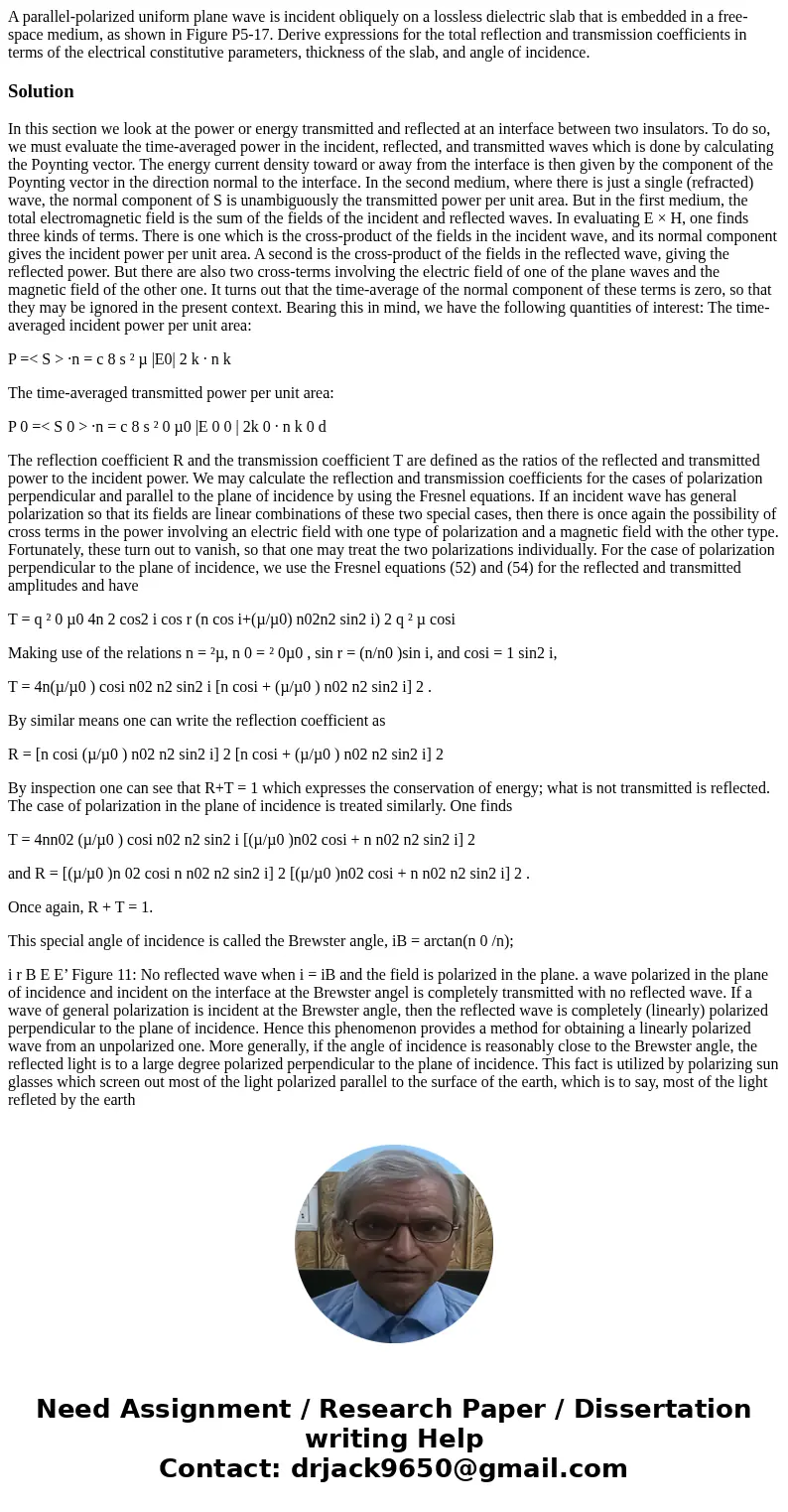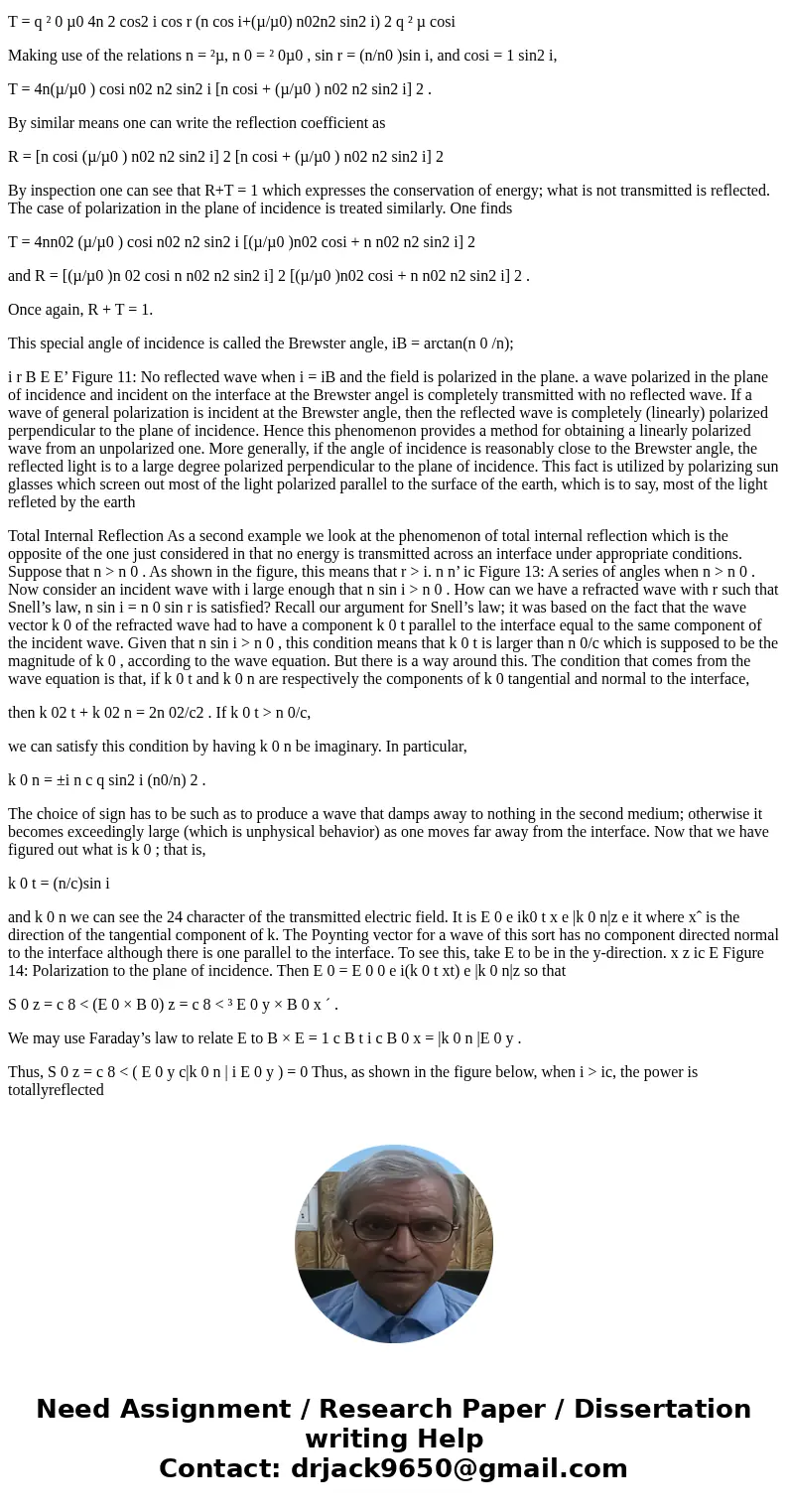A parallelpolarized uniform plane wave is incident obliquely
Solution
In this section we look at the power or energy transmitted and reflected at an interface between two insulators. To do so, we must evaluate the time-averaged power in the incident, reflected, and transmitted waves which is done by calculating the Poynting vector. The energy current density toward or away from the interface is then given by the component of the Poynting vector in the direction normal to the interface. In the second medium, where there is just a single (refracted) wave, the normal component of S is unambiguously the transmitted power per unit area. But in the first medium, the total electromagnetic field is the sum of the fields of the incident and reflected waves. In evaluating E × H, one finds three kinds of terms. There is one which is the cross-product of the fields in the incident wave, and its normal component gives the incident power per unit area. A second is the cross-product of the fields in the reflected wave, giving the reflected power. But there are also two cross-terms involving the electric field of one of the plane waves and the magnetic field of the other one. It turns out that the time-average of the normal component of these terms is zero, so that they may be ignored in the present context. Bearing this in mind, we have the following quantities of interest: The time-averaged incident power per unit area:
P =< S > ·n = c 8 s ² µ |E0| 2 k · n k
The time-averaged transmitted power per unit area:
P 0 =< S 0 > ·n = c 8 s ² 0 µ0 |E 0 0 | 2k 0 · n k 0 d
The reflection coefficient R and the transmission coefficient T are defined as the ratios of the reflected and transmitted power to the incident power. We may calculate the reflection and transmission coefficients for the cases of polarization perpendicular and parallel to the plane of incidence by using the Fresnel equations. If an incident wave has general polarization so that its fields are linear combinations of these two special cases, then there is once again the possibility of cross terms in the power involving an electric field with one type of polarization and a magnetic field with the other type. Fortunately, these turn out to vanish, so that one may treat the two polarizations individually. For the case of polarization perpendicular to the plane of incidence, we use the Fresnel equations (52) and (54) for the reflected and transmitted amplitudes and have
T = q ² 0 µ0 4n 2 cos2 i cos r (n cos i+(µ/µ0) n02n2 sin2 i) 2 q ² µ cosi
Making use of the relations n = ²µ, n 0 = ² 0µ0 , sin r = (n/n0 )sin i, and cosi = 1 sin2 i,
T = 4n(µ/µ0 ) cosi n02 n2 sin2 i [n cosi + (µ/µ0 ) n02 n2 sin2 i] 2 .
By similar means one can write the reflection coefficient as
R = [n cosi (µ/µ0 ) n02 n2 sin2 i] 2 [n cosi + (µ/µ0 ) n02 n2 sin2 i] 2
By inspection one can see that R+T = 1 which expresses the conservation of energy; what is not transmitted is reflected. The case of polarization in the plane of incidence is treated similarly. One finds
T = 4nn02 (µ/µ0 ) cosi n02 n2 sin2 i [(µ/µ0 )n02 cosi + n n02 n2 sin2 i] 2
and R = [(µ/µ0 )n 02 cosi n n02 n2 sin2 i] 2 [(µ/µ0 )n02 cosi + n n02 n2 sin2 i] 2 .
Once again, R + T = 1.
This special angle of incidence is called the Brewster angle, iB = arctan(n 0 /n);
i r B E E’ Figure 11: No reflected wave when i = iB and the field is polarized in the plane. a wave polarized in the plane of incidence and incident on the interface at the Brewster angel is completely transmitted with no reflected wave. If a wave of general polarization is incident at the Brewster angle, then the reflected wave is completely (linearly) polarized perpendicular to the plane of incidence. Hence this phenomenon provides a method for obtaining a linearly polarized wave from an unpolarized one. More generally, if the angle of incidence is reasonably close to the Brewster angle, the reflected light is to a large degree polarized perpendicular to the plane of incidence. This fact is utilized by polarizing sun glasses which screen out most of the light polarized parallel to the surface of the earth, which is to say, most of the light refleted by the earth
Total Internal Reflection As a second example we look at the phenomenon of total internal reflection which is the opposite of the one just considered in that no energy is transmitted across an interface under appropriate conditions. Suppose that n > n 0 . As shown in the figure, this means that r > i. n n’ ic Figure 13: A series of angles when n > n 0 . Now consider an incident wave with i large enough that n sin i > n 0 . How can we have a refracted wave with r such that Snell’s law, n sin i = n 0 sin r is satisfied? Recall our argument for Snell’s law; it was based on the fact that the wave vector k 0 of the refracted wave had to have a component k 0 t parallel to the interface equal to the same component of the incident wave. Given that n sin i > n 0 , this condition means that k 0 t is larger than n 0/c which is supposed to be the magnitude of k 0 , according to the wave equation. But there is a way around this. The condition that comes from the wave equation is that, if k 0 t and k 0 n are respectively the components of k 0 tangential and normal to the interface,
then k 02 t + k 02 n = 2n 02/c2 . If k 0 t > n 0/c,
we can satisfy this condition by having k 0 n be imaginary. In particular,
k 0 n = ±i n c q sin2 i (n0/n) 2 .
The choice of sign has to be such as to produce a wave that damps away to nothing in the second medium; otherwise it becomes exceedingly large (which is unphysical behavior) as one moves far away from the interface. Now that we have figured out what is k 0 ; that is,
k 0 t = (n/c)sin i
and k 0 n we can see the 24 character of the transmitted electric field. It is E 0 e ik0 t x e |k 0 n|z e it where xˆ is the direction of the tangential component of k. The Poynting vector for a wave of this sort has no component directed normal to the interface although there is one parallel to the interface. To see this, take E to be in the y-direction. x z ic E Figure 14: Polarization to the plane of incidence. Then E 0 = E 0 0 e i(k 0 t xt) e |k 0 n|z so that
S 0 z = c 8 < (E 0 × B 0) z = c 8 < ³ E 0 y × B 0 x ´ .
We may use Faraday’s law to relate E to B × E = 1 c B t i c B 0 x = |k 0 n |E 0 y .
Thus, S 0 z = c 8 < ( E 0 y c|k 0 n | i E 0 y ) = 0 Thus, as shown in the figure below, when i > ic, the power is totallyreflected


 Homework Sourse
Homework Sourse